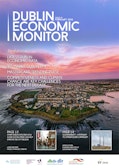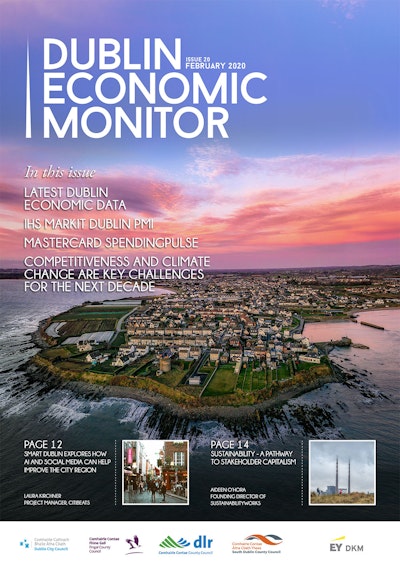According to the latest Dublin Economic Monitor (DEM) published this morning, which is produced by EY-DKM Economic Advisory on behalf of the four Dublin Local Authorities, business activity showed a modest pick-up in Dublin in Q4 2019.
Receding global trade tensions and temporary clarity over Brexit helped Manufacturing return to expansionary territory for the first time since Q4 2018 and Services output accelerate. This saw the overall IHS Markit Purchasing Managers Index (PMI) rise to 53.7. This contrasts with the rest of Ireland where the index fell below 50 for the first time since Q3 2013.
Brexit uncertainty was still apparent in Dublin Port in Q3 with throughput seeing its second consecutive quarter of QoQ decline. This is one to watch in the coming quarters as negotiations surrounding the future trading relationship between the EU and the UK will likely see continued volatility in imports and exports.
Andrew Harker, Associate Director at IHS Markit said:
“The pick-up in output growth in the final quarter of 2019 provides some optimism that firms in Dublin will see further improvements in momentum in early-2020, as the uncertainty surrounding Brexit that has held the wider economy back lifts for the time being. While the Rest of Ireland saw output dip into contraction, any reinvigoration of growth in the capital should help the rest of the country head back into expansion mode.”
Commenting on the report’s findings, Ciara Morley, Economist with EY-DKM Economic Advisory, said:
“Since the economic crises at the beginning of the last decade, Dublin has emerged as one of the fastest growing cities in one of the fastest growing economies in Europe. Unemployment is now at its lowest level in almost 15 years and the workforce is at an all-time high. There is little doubt, however, that this success has brought with it its own challenges and Dublin is now facing several issues that are impacting its international competitiveness. Our analysis shows, for example, that the challenges in the housing market – where average residential rents have increased in Dublin by 6.7% Year on Year (YoY) are causing a drag on Dublin’s position in rankings focused on the quality and cost of living. Policies to boost housing supply, and thus affordability, in the city should go some way to improving the quality and cost of living for residents and expatriates alike.”
Mastercard SpendingPulse™ data sees tourist spending ease
The Mastercard SpendingPulse™, published as part of the DEM, shows that despite weakness in spending on discretionary goods, Dublin retail sales growth was solid in Q4 2019 (3.3% YoY SA).
Tourist spending growth continued to ease with spending across Ireland up 4% YoY (SA) and up 3.7% (SA) YoY in Dublin – both were in double digit territory throughout 2018. While tourist spending from the USA continues to grow strongly, this is offset by weakness in spending from the British, German, French and Chinese tourists. Weakness in the latter was more pronounced in Dublin (+4.1% YoY SA) versus nationally (+7.6% YoY SA).
Michael McNamara, Global Head of SpendingPulse, Mastercard, said on consumer spending:
“While the growth rates may appear more modest on the surface, when taken in context with the spending surge in 2018, the growth in Q4 was solid. As the economy in the USA remains on solid footing, it is reasonable to expect more positive tourist spending as we enter 2020.”


